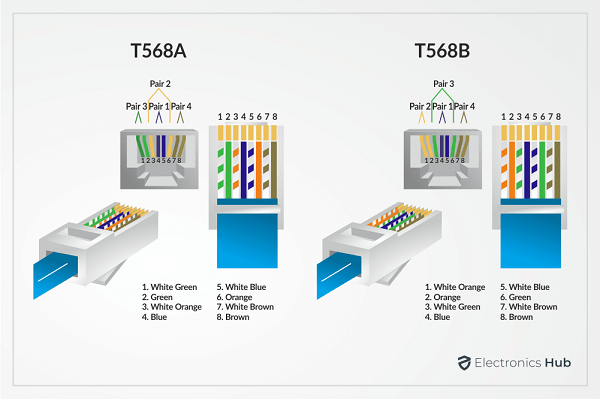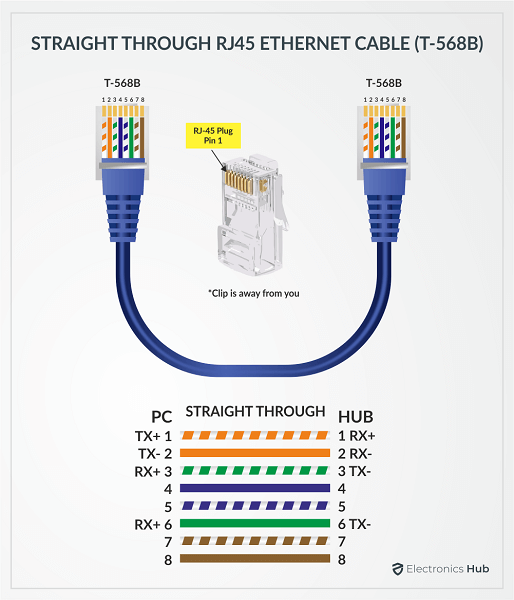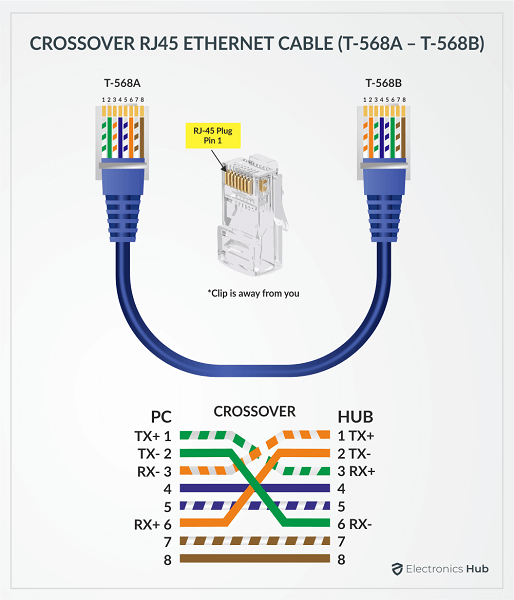Even though wireless networks such as Wi-Fi are getting faster and cheaper, wired networks are still a dominating part of the overall networking infrastructure. Wired local area networks (LANs) are used in homes, offices, stores, data centers and many more. If you are a networking administrator or if you are trying to wire-up your own local area network in your home, then knowing the Pinout of the Ethernet connector is very handy. So, in this guide, we will explore the world of ethernet cables and connectors and also take a look at the Ethernet Pinout for RJ-45 jack.
Outline
ToggleCabling Standardization Bodies
For smooth interoperability between different electrical /electronic equipment, communication systems and other technologies, several standard bodies and organizations publish specifications for hardware, software and physical infrastructure.
The ANSI/TIA/EIA (American National Standards Institute, Telecommunications Industries Association, Electronic Industries Association) and the ISO/IEC (International Standards Organization, International Electronics Components) are the two popular and widely used cabling standards.
TIA/EIA Standard 568 is the most popular cabling standard in the US that defines a structured cabling system for twisted pair cables and also the pin assignment for the 8-pin RJ-45 connector.
The TIA/EIA 568 standard also has specifications for different ‘categories’ of twisted-pair cable. If you are familiar with CAT cables that we commonly use for our networking needs, they are actually defined in the TIA/EIA 568 standard.
Some popular twisted-pair cable categories are CAT-5, CAT-5e, CAT-6 and CAT-6A. ISO/IEC Standard 11801 is very similar to the TIA/EIA 568 standard and is used in Europe.
As the TIA/EIA 568 is a more popular specification (and the ISO/IEC 11801 is based on TIA/EIA 568), we are going to discuss the cable pin assignments and ethernet pinout with respect to TIA/EIA 568 Standard. But before taking a look at the actual pinout, let us briefly discuss the importance of twisted-pair cables.
Twisted-Pair Cables
Coaxial Cable was the first commercial networking cable. It consists of two conductors with the same axis (hence the name coaxial). At the center of the cable, a solid copper wire acts as the first conductor core that carries the actual signal. This is covered by a dielectric foam and it separates the first conductor and second conductor.
Speaking of the second conductor, it is a braided wire mesh that acts as a signal ground. The entire assembly is then covered with an outer protective sheath. The use of coaxial cables for networking is almost non-existent nowadays but they are still used for cable television.
Most of the modern local area network cabling uses twisted pair cables. They are easy to install and provide better performance than other cable types (Coaxial, Thick Ethernet and Thin Ethernet cables).
In contrast to coaxial cables, which use one copper conductor and one ground mesh, twisted pair cables generally use four twisted pairs of insulated copper wires. While the twisted pair cables are resistant to Electromagnetic Interference (EMI), either from other pairs or from outside, they are not suitable for transmission of high frequency signals. As a result, a segment of twisted pair cable is often limited to a length of 100m.
The Unshielded Twisted Pair or UTP cable is the most commonly used type for ethernet networks. It uses 22 or 24 AWG copper conductors with a resistance of 100 Ohm. The TIA/EIA 568 standard also defines several categories of UTP cables based on performance levels.
| Category | Name | Speed | Max. Length | Application | Max. Frequency |
| Cat 1 | Analog Telephone | 1 MHz | |||
| Cat 3 | Telephone Wiring, Computer Networking | 10 Mbps | 10Base-T | 16 MHz | |
| Cat 5 | Fast Ethernet | 100 Mbps | 100m (328ft.) | 100Base-T | 100 MHz |
| Cat 5e | Gigabit Ethernet | 1 Gbps | 100m (328ft.) | 1GBase-T | 250 MHz |
| Cat 6 | 10 Gigabit Ethernet | 10 Gbps | 50m (164ft.) | 10GBase-T | 250 MHz |
| Cat 6a | 10 Gigabit Ethernet | 10 Gbps | 100m (328ft.) | 10GBase-T | 500 MHz |
RJ-45 Ethernet Cable Pinout
Twisted Pair Cables use RJ-45 (Registered Jack) connector
Coming to the main point of this article, the Ethernet Pinout, the TIA/EIA color-coded the four twisted pairs cables as per the TIA/EIA – T568-A or TIA/EIA – T568-B standard. The following table shows the cable colors in each standard.
| T-568A | Color Code | T-568B | Color Code |
| Pair 1 | Solid Blue, White/Blue Stripes | Pair 1 | Solid Blue, White/Blue Stripes |
| Pair 2 | Solid Orange, White/Orange Stripes | Pair 2 | Solid Orange, White/Orange Stripes |
| Pair 3 | Solid Green, White/Green Stripes | Pair 3 | Solid Green, White/Green Stripes |
| Pair 4 | Solid Brown, White/Brown Stripes | Pair 4 | Solid Brown, White/Brown Stripes |
Coming to the images, the following images show the pinout for T-568A as well as T-568B standards.
In a straight through LAN cable, both ends of the cable have the same style of pinout. Since most modern LAN cables use T-568B style ethernet pinout, a typical straight through LAN cable will have both ends with T-568B pinout.

 Conclusion
Conclusion
An introductory guide on ethernet cables, industry standards for ethernet cabling, termination and also commonly used ethernet pinout. T-568A and T-568B are two popular standards for RJ-45 ethernet cable termination. Depending on the application, there can also be a straight through connection or a crossover connection.


